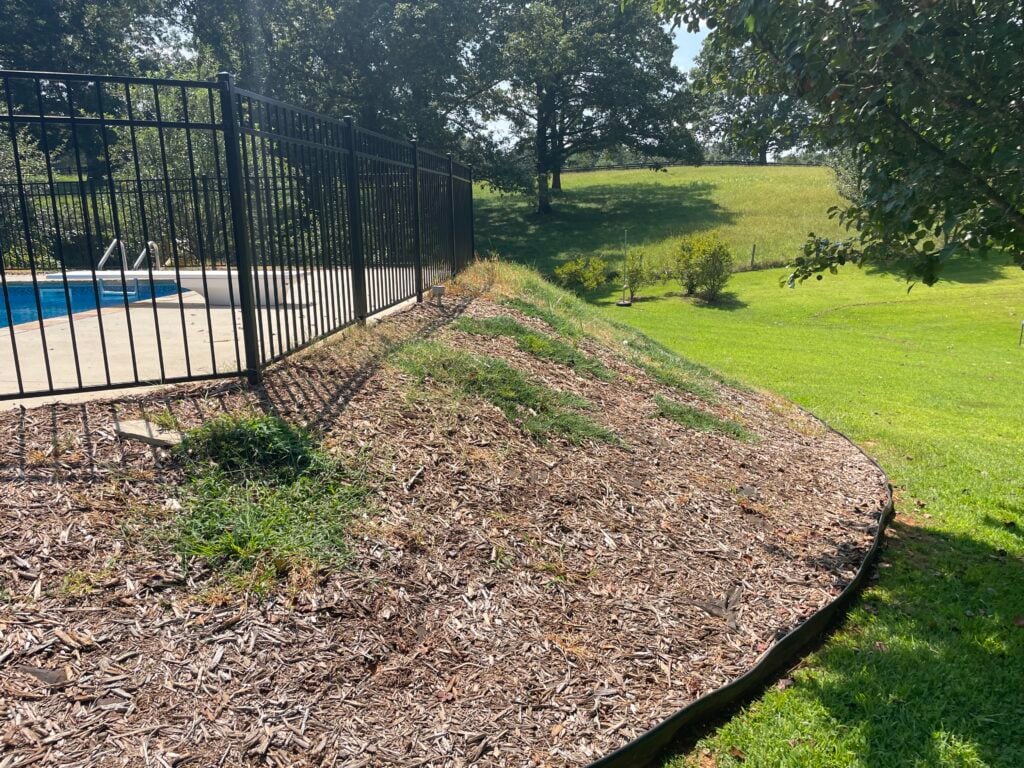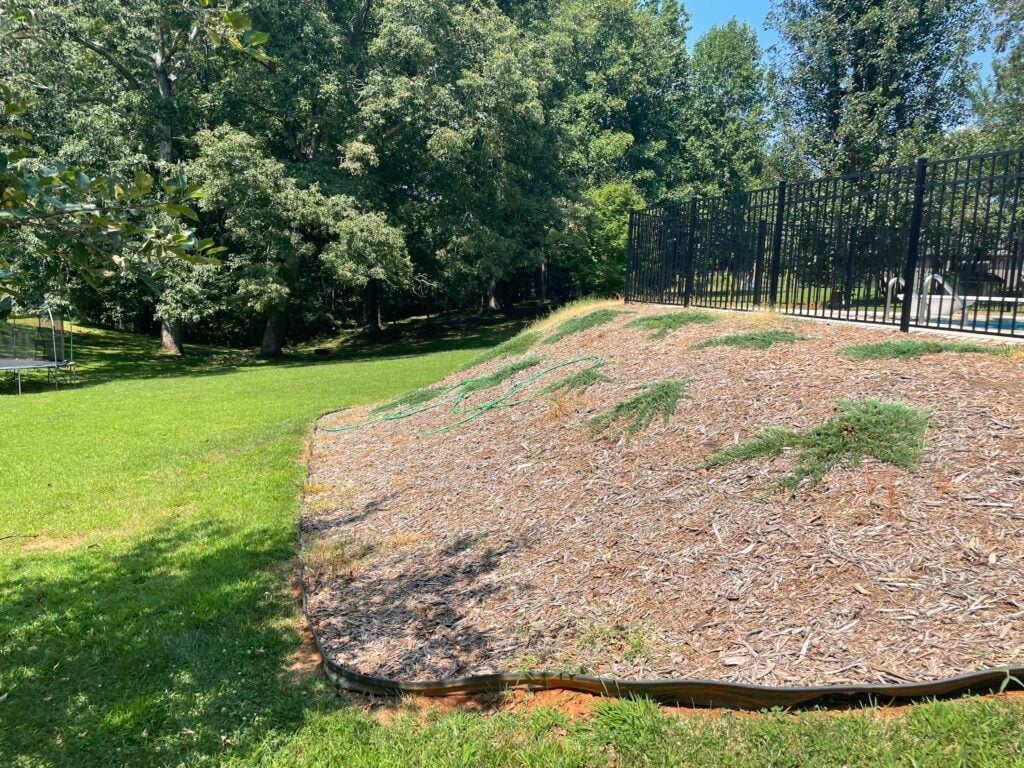As I mentioned a few days ago, we’re getting a pool. However, my backyard is pretty sloped. As a result, we had to install a retaining wall at one end of the pool so that we could sink that end of the pool down below grade by a few fees, while the opposite corner of the pool required quite a bit of backfill.
This has left us with a steep bank – too steep to mow or walk on safely – but one where we cannot allow any significant erosion or the dirt will wash out from under the back corner of the pool deck.

After a bit of research, I settled on the following combination of materials to try to stabilize and maintain this hillside.
- Landscape fabric is the first layer of defense. The landscape fabric accomplishes two things: it stops water from being able to run down the bank and carry off a bunch of dirt and it will also help slow the growth of weeds which will be difficult to deal with on this steep bank if they get out of control.
- Jute netting stretched tight and fastened to the bank with 6″ landscape staples. This will provide further protection from runoff and also give the junipers and ground covering material a surface to hold onto.
- Blue rug junipers planted approximately six feet (2 meters) apart. Eventually, each should grow to roughly six feet by six feet (2 meters by two meters) meaning eventually the entire bank should be covered in junipers. That will take a few years though. I planted twenty junipers already and need about ten more to finish this part of the project but Lowe’s it sold out at the moment.
- Mulch or pine straw will eventually be installed over the jute. I haven’t decided which to use. Mulch will last longer and provide better protection to the bank. However, pine straw costs less and is a lot easier to install. In the end, I will probably use pine straw at first, for the sake of speed, and then cover it with mulch in the Spring or Summer.
- Resin dig-in edging runs along the base of the bank to provide a clear point of separation between the bed and lawn. The raised edge of the resin edging will also help keep the mulch or pine straw from washing out into the lawn. Now that it’s installed, I’m not particularly thrilled with the look of this product, but I think it will get the job done and it’s already in the ground so I’m sticking with it for now.
I’m nearing the end of getting these various erosion control measures in place. The landscape fabric and jute netting are in place. Most of the junipers have been planted, all but about 10 feet of the resin edging have been installed. At this point all I have left is to plant about 10 more junipers (once I find them), finish digging in the last 10 feet of edging, and then spread a few inches of mulch or pine straw across the hillside. Then I’ll be ready to move on to the next step: installing the fence around the pool deck.
I think the measures I’ve put in place will stabilize this bank just fine. We’ve had quite a bit of rain since I planted the junipers and installed the landscape fabric and already that seemed to do the trick. So I feel pretty confident that the full combination of measures will be more than enough. However, if these measures do prove to be insufficient, the next option is to build a retaining wall at the bottom of the hill and to backfill a bunch of dirt inside the retaining wall. Hopefully we can avoid that scenario because it’ll carry a pretty painful price tag.
Update: August 2023
This post was originally written in December 2021. It’s been roughly 20 months since that post and I wanted to provide an update on how this project turned out.
The jute netting did a great job of preventing erosion and providing a surface for mulch to hold onto. It lasted roughly a year and then started to break apart. At this point, the jute netting is effectively gone, but the hillside is stabilized and the junipers I planted have had enough time to become established.
All things considered, I’ve very happy with how this project turned out and with the performance of the jute netting. My only dissatisfaction is with my own lack of weeding to keep up the appearance of this hillside.




Hi, I am considering adding landscape fabric on a steep hill with jute too. Did you feel like the jute material held onto the mulch or did the mulch slide off? I am also worried about the mulch sliding off once the jute material degrades. What was your experience?
The jute has been on the hillside for about 6 months now and is in pretty decent shape. I do think it helped hold the mulch in place quite a bit. I recently refreshed the mulch at the top of the hill and the jute is still there and doing it’s job. The mulch does lock together once it’s been in place a few weeks so the jute really only needs to hold it for that long.
Interested in seeing some pics of your progress. I am working on a similar slope and wondering how the pine straw works on the weed cloth.
It’s turned out great. I need to weed the hillside but the jute did a great job of holding the hillside, giving the mulch something to hold on to, and allowing the junipers some time to get established. A bunch of weeds and bermuda also established, and that I need to pull, but the jute did it’s job! I’ll grab some pictures this week to update this post.
NancyL I added a few photos! The jute netting is basically gone at this point but it did it’s job and lasted roughly a year before disintegrating.
Hi there. Did you cut a hole in both the landscape fabric and the jute to plant the junipers? Did you have to do that when you added each layer? What did you use to cut them?
I want to plant stuff around our new slope/hillside but not sure what I want yet. I know I need to get fabric and jute down ASAP, as the dirt runs off during heavy rains.
Dig a small trench and ditch the plastic edging. Plant more stuff.
Creating a safe and durable play space is essential for kids’ activities, and high-quality play area turf is a great solution! It provides a soft, cushioned surface that minimizes injuries while requiring minimal maintenance. Have you considered installing artificial turf for playgrounds? It’s a game-changer for both residential and commercial spaces!